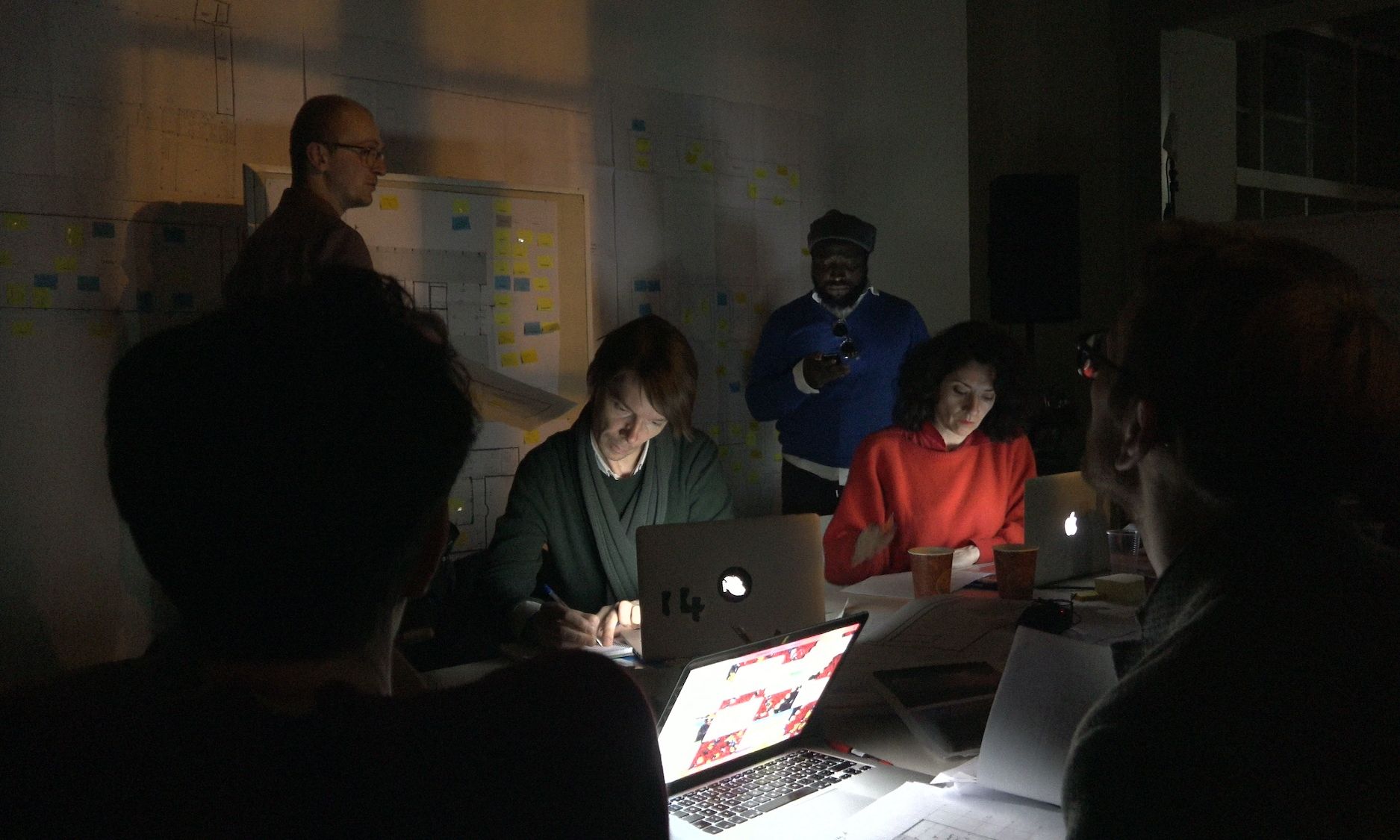From left to right: Hendrik Folkerts, Adam Szymczyk, Bonaventure Soh Bejeng Ndikung and Katerina Tselou in exergue – documenta 14 (2024) © Faliro House Productions
Can staff meetings in nondescript rooms become compelling cinema? Stanley Kubrick did it in 1964 with Dr Strangelove, but he had Peter Sellers, George C. Scott and Slim Pickens riding a nuclear bomb toward Earth. The new, 14-hour documentary exergue – on documenta 14 (2024) offers an extended look—more long than grand—into the planning and assembling of the titular international art exhibition in 2017. Most recently screened at the New York Film Festival, after a stop at the Toronto International Film Festival, exergue, directed, edited and shot by the Greek film-maker Dimitris Athiridis, is a study in curatorial ambition and deliberative governance. Given its length—840 minutes to be exact—it suits the model of a series, although it is being screened in marathon segments, inevitably for a niche audience.
In 2013 Adam Szymczyk, then an ascendant curatorial force and the chief curator of Kunsthaus Basel, was selected to be the artistic director of the Documenta quinquennial’s next edition. His goals included showing artists from outside Western Europe and including more performance art. Another goal was for his Documenta to be staged both in the exhibition’s traditional home base of Kassel, Germany, and Athens. That decision worried Germans, who saw Greece as a spendthrift country seeking cash once again from a solvent Germany.
Adam Szymczyk in exergue – documenta 14 (2024) © Faliro House Productions
Szymczyk's diversity goals fit with the zeitgeist of the contemporary art world, already longstanding at the time, and seemed intended to shake things up with the inclusion of artists like Danai Anesiadou, who imagined presenting an overflowing sewer. We watch as Szymczyk's team visits Norway and meets with a Sami activist, Niillas Somby, who was imprisoned after he blew his arm off trying to bomb a bridge—just a gesture, he explained. The philosopher Antonio Negri (1933-2023), who co-authored the influential book Empire (2000) and was jailed in Italy on murder charges after years as a fugitive in France, was an adviser. In meetings, the most-cited enemy was neo-liberalism. Wealthy donors who filled the exhibition’s funding gaps were scorned as necessary evils.
Also in the zeitgeist was the uncomfortable spectre of Nazi looting. Szymczyk tried without success to show pillaged work that had recently been seized from the Munich apartment of Cornelius Gurlitt, who hoarded art acquired by his father, Hildebrandt Gurlitt, a buyer for the Nazis.
Most of what Szymczyk and his team did was less dramatic than these associations suggest. They sought out artists, all of whom needed money. They also sought money. “Exergue” is a word for an inscription on a coin.
Kostas Tsioukas performing Collective exhibition for a Single Body by Pierre Bal Blanc in exergue – documenta 14 (2024) © Faliro House Productions
And they negotiated with Greek officials, slowing things down and almost losing their main venue in Athens. Here the film is instructive in tracking the challenges of managing the logistical side of projects like Documenta. Szymczyk and company prove to be composed and methodical, slashing budgets when faced with massive costs. Pale, thin and pokerfaced, Szymczyk, who at times resembles the television actor David Caruso, has a managerial sang-froid that bears watching, defying stereotypes about arts administrators. Finally, with the Athens side of the project in jeopardy amid threats and tensions, the director of the EMST, the contemporary art museum there, reaches a deal with Documenta.
In the end, Documenta 14 did open on schedule, with more than 150 participating artists. It's hard to ask for extra time in a 14-hour film, but audiences may find that the art itself merits more attention that the film gives it.
While exergue could have ended with the art finally going on view, it then shifts to watch Documenta 14 under attack for its perceived Left-leaning politics and lax management. (One wonders what was so wrong in Kassel if populists on the Right seeking villains were left attacking an ensemble of art spaces.) Documenta 14 offered a cocktail of issues that irked some of its German constituents: Leftist politics, transgressive works (often indecipherable to the general public) from developing countries that were sending migrants into Germany, a queer-friendly atmosphere and a budget partly drawn from their taxes. When it emerged that Documenta produced a deficit of more than €7m, the opponents had all the proof of Leftist overreach they needed.
The Parthenon of Books (2017) by Marta Minujín in Kassel, Germany, during Documenta 14 © Faliro House Productions
Seven years later, Documenta 14 can be seen as consistent with its time, if inclusion is the standard. By another ominous metric, its angry opponents on the Right now have even more influence over German and European politics. In the film’s final chapter Szymczyk, who encouraged a strong political resonance in his programme, wanders around stunned by political attacks from forces that he underestimated. Today those emboldened populist critics have a bigger fish to fry, Germany itself.
Ultimately exergue is a film about art’s power and its limits. Documenta, valuable as an engine of economic activity, now has a higher budget than it did in 2017. (But, following an antisemitism scandal at its next edition in 2022, it has also come under even tighter political scrutiny and curatorial oversight.)
A novelty, exergue is also a twist on the “making of” documentary formula, a film about the making of a larger project that used to accompany video releases. It will not be a one-off. In the competitive art world, film-makers (some better known than Dimitris Athiridis) are probably saying that they can do things better. And for them, better could mean even longer, although probably on a smaller screen.

